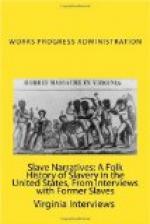Mr. Edmunds states that the Negro people prefer to be referred to as colored people, and deeply resent the name “nigger.”
Archie Koritz, Field Worker
Federal Writers’ Project
Lake County—District #1
Gary, Indiana
Ex-slaves
John Eubanks & family
Gary, Indiana
Gary’s only surviving Civil War veteran was born a slave in Barren County, Kentucky, June 6, 1836. His father was a mulatto and a free negro. His mother was a slave on the Everrett plantation and his grandparents ware full-blooded African negroes. As a child he began work as soon as possible and was put to work hoeing and picking cotton and any other odd jobs that would keep him busy. He was one of a family of several children, and is the sole survivor, a brother living in Indianapolis, having died there in 1935.
Following the custom of the south, when the children of the Everrett family grew up, they married and slaves were given them for wedding presents. John was given to a daughter who married a man of the name of Eubanks, hence his name, John Eubanks. John was one of the more fortunate slaves in that his mistress and master were kind and they were in a state divided on the question of slavery. They favored the north. The rest of the children were given to other members of the Everrett family upon their marriage or sold down the river and never saw one another until after the close of the Civil War.
Shortly after the beginning of the Civil War, when the north seemed to be losing, someone conceived the idea of forming negro regiments and as an inducement to the slaves, they offered them freedom if they would join the Union forces. John’s mistress and master told him that if he wished to join the Union forces, he had their consent and would not have to run away like other slaves were doing. At the beginning of the war, John was twenty-one years of age. When Lincoln freed the slaves by his Emancipation Proclamation, John was promptly given his freedom by his master and mistress.
John decided to join the northern army which was located at Bowling Green, Kentucky, a distance of thirty-five miles from Glasgow where John was living. He had to walk the entire thirty-five miles. Although he fails to remember all the units that he was attached to, he does remember that it was part of General Sherman’s army. His regiment started with Sherman on his famous march through Georgia, but for some reason unknown to John, shortly after the campaign was on its way, his regiment was recalled and sent elsewhere.
His regiment was near Vicksburg, Mississippi, at the time Lee surrendered. Since Lee was a proud southerner and did not want the negroes present when he surrendered, Grant probably for this reason as much as any other refused to accept Lee’s sword. When Lee surrendered there was much shouting among the troops and John was one of many put to work loading cannons on boats to be shipped up the river. His company returned on the steamboat “Indiana.” Upon his return to Glasgow, [HW: Ky.] he saw for the first time in six years, his mother and other members of his family who had returned free.




